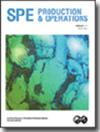回顾旋风低剪切节流阀和控制阀的应用经验
IF 1.3
4区 工程技术
Q2 ENGINEERING, PETROLEUM
引用次数: 1
摘要
在碳氢化合物生产和加工中,节流阀和控制阀混合和乳化石油相。其结果往往是分离过程的效率受到影响,并最终导致油相和水相的质量下降。在过去的几年里,市场上出现了针对石油工艺的低剪切阀。本文介绍了低剪切阀装置的四种不同的活流体体验,每种体验都由独立的第三方进行调查和记录。其中三个装置涉及节流阀,而第四个装置涉及控制阀。对于每个安装,都使用标准节流阀和控制阀作为参考阀。就下游分离效率而言,低剪切节流阀将水包油浓度分别平均降低了70%、45%和60%。在控制阀应用中,位于水力旋流器和紧凑型浮选装置之间的低剪切阀将水包油浓度降低了23%。总之,现场装置已经证明,低剪切阀显著且持续地降低了水中的油浓度,从而改善了采出水的质量。结果表明,低剪切阀可用于脱瓶颈分离和采出水处理过程,减少了采出水排放对环境的影响。由于低剪切技术能够以更少的精力、能源和化学品处理石油相,因此它还减少了对空气的排放。本文章由计算机程序翻译,如有差异,请以英文原文为准。
Reviewing Cyclonic Low-Shear Choke and Control Valve Field Experiences
In hydrocarbon production and processing, choke and control valves mix and emulsify petroleum phases. The consequence is often that the efficiency of separation processes is affected and finally that the quality of oil and water phases is degraded. Over the last few years, low-shear valves targeting petroleum processes have emerged on the market.
This paper presents four separate live-fluid experiences from low-shear valve installations, each surveyed and documented by an independent third party. Three of the installations refer to choke valves, whereas the fourth installation refers to a control valve. For each installation, standard choke and control valves were used as reference valves. In terms of downstream separation efficiency, the low-shear choke valves reduced oil-in-water concentrations respectively by 70, 45, and 60%, by total average. In the control valve application, the low-shear valve, which was located between the hydrocyclones and a compact flotation unit, reduced the oil-in-water concentration by 23%.
In sum, the field installations have demonstrated that low-shear valves significantly and consistently reduce oil-in-water concentrations and thus improve the produced water quality. The results signify that low-shear valves may be used in debottlenecking separation and produced water treatment processes, reducing the environmental influence from produced water discharges. Because the low-shear technology enables processing of petroleum phases with less effort, energy, and chemicals, it also reduces emissions to air.
求助全文
通过发布文献求助,成功后即可免费获取论文全文。
去求助
来源期刊

Spe Production & Operations
工程技术-工程:石油
CiteScore
3.70
自引率
8.30%
发文量
54
审稿时长
3 months
期刊介绍:
SPE Production & Operations includes papers on production operations, artificial lift, downhole equipment, formation damage control, multiphase flow, workovers, stimulation, facility design and operations, water treatment, project management, construction methods and equipment, and related PFC systems and emerging technologies.
 求助内容:
求助内容: 应助结果提醒方式:
应助结果提醒方式:


